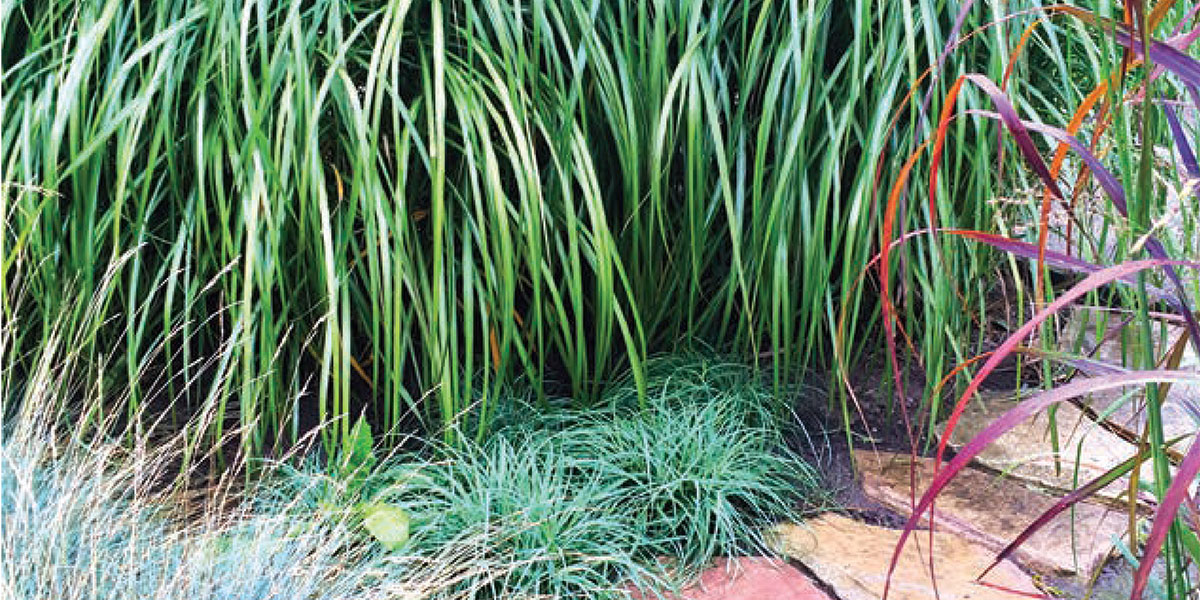
Looking for a low-maintenance addition to your landscape that you can rely on all year for show-stopping good looks? Look no further than ornamental grasses. These hardy perennials are a fantastic addition to your Smith Mountain Lake home for a long list of reasons. They can help prevent erosion—not just on the slope to the lake but around the shoreline—while also offering a wildlife habitat. They don’t require regular maintenance, and are available in a wide array of colors, textures and sizes, keeping an attractive appearance most of the year. They offer delicate and sometimes striking blossoms, fall color, and movement in a breeze. They can be planted individually as a specimen plant, in place of shrubs, or in multiples as a border. In short, there’s almost nothing ornamental grasses can’t do in the garden.
There are two types of ornamental grasses: cool-season and warm-season grasses. Cool-season grasses remain semi-evergreen throughout the winter, flowering in the spring and early summer on foliage grown in the fall. Warm-season grasses grow in late spring and flower in late summer and fall. They can vary in their growth habits; there are short, clumping grasses and tall varieties that spread by their roots, or rhizomes. Both types range between 1 to 6 feet in height and 1 to 3 feet wide, and both can be pruned and split in early spring. Clumping types will begin to die back in the center, indicating it’s time to dig them up and split them into smaller sections, usually every 3 to 4 years. Cool grasses are best planted in fall while warm grasses prefer spring, both needing to be watered until they are established. But once established, your ornamental grasses will require only occasional minimal effort.
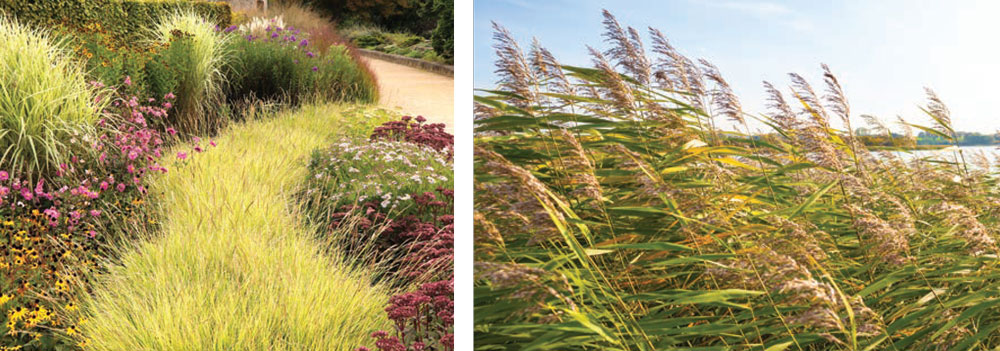
There are a number of native ornamental grasses, both cool- and warm-season varieties, to consider for your landscape. Native are always considered best, as they are better adapted to the conditions of our region and will require less effort to thrive. They also provide food and shelter for native birds and insects, and are less likely to become invasive and destroy natural habitat.
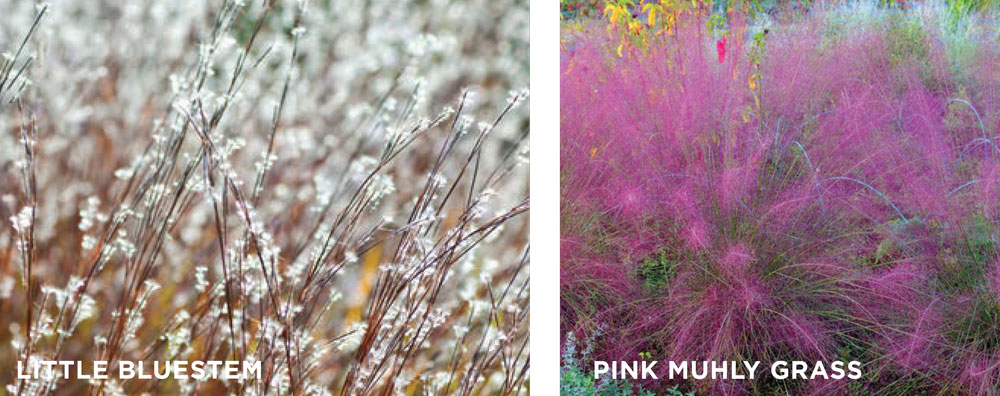
Little Bluestem is an unfussy native that requires only a sunny spot. A warm-weather grass, the blue-tinged leaves grow to be 2 to 4 feet tall, making it a great substitute for shrubs. It forms bronze blooms in late summer while the leaves turn bronze-orange. Pink muhly grass is another native warm-weather grass that has a spectacular autumn display of color with its pink flowers. Drought and wind tolerant, it prefers to be planted in large clumps in full sun. The “White Cloud” variety produces white flowers that resemble little white clouds.
Woolgrass prefers wetter soil, making it a good one to plant near water, as it provides excellent erosion control when planted en masse. Their blades grow to about 2 to 3 feet tall and pop out a summer bloom in the form of a compound umbel (a flower cluster in which stalks of almost equal length spring from a common center, like that of Queen Anne’s lace) that become wooly at maturity and remain attractive well into winter.
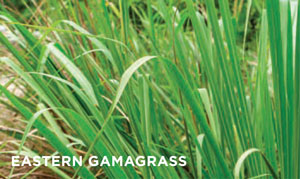 Another good ornamental grass for erosion control is Eastern gamagrass. This warm-season grass grows to be 4 to 8 feet tall in average-to-moist soil, preferring full sun or partial shade. It sends up floral spikes mid-spring to early summer with orange stamens (male flowers) and purple stigmas (female flowers). The foliage turns orange-pink in the fall and makes quite the statement in your landscape. Fountain grass, named for the shape its cascading leaves assume, makes a spectacular specimen plant. It offers foxtail-looking flowers in late summer that come in a range of colors, from tan (that fade to pink) to purple and red. It does well in almost any type of soil, in full sun as well as partial shade. Planted as a single plant, it is a dramatic centerpiece, or planted in a grouping makes a striking border.
Another good ornamental grass for erosion control is Eastern gamagrass. This warm-season grass grows to be 4 to 8 feet tall in average-to-moist soil, preferring full sun or partial shade. It sends up floral spikes mid-spring to early summer with orange stamens (male flowers) and purple stigmas (female flowers). The foliage turns orange-pink in the fall and makes quite the statement in your landscape. Fountain grass, named for the shape its cascading leaves assume, makes a spectacular specimen plant. It offers foxtail-looking flowers in late summer that come in a range of colors, from tan (that fade to pink) to purple and red. It does well in almost any type of soil, in full sun as well as partial shade. Planted as a single plant, it is a dramatic centerpiece, or planted in a grouping makes a striking border.
For cool-season grasses, there are also a wide variety of native offerings, including the Pennsylvania sedge. This low-growing, drought-tolerant grass reaches only a few inches tall, making it an excellent ground cover in shady areas. It also works well as a border plant for shade gardens. Another sedge to consider is the fringed sedge, which does well in full sun to partial shade and wet soil, making it a great grass to plant along water. In late spring, taller blades pop up with hanging seedheads that resemble fringe, hence the name.
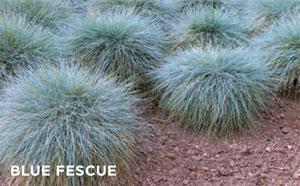 Blue fescue, with its soft, silvery-blue leaves is a lovely addition to the garden. Preferring sunny, well-drained soil, it makes an excellent ground cover or border, as it remains fairly short—under 2 feet tall. For a taller but also attractive cool grass, purple moor grass has textured blue-green blades that contrast with purple blooms that fade to bronze in fall as the foliage turns golden. It slowly reaches a height of 3 feet and prefers morning sun with afternoon shade. Plant purple moor grass either as a focal point in your garden or en masse as a hedgerow.
Blue fescue, with its soft, silvery-blue leaves is a lovely addition to the garden. Preferring sunny, well-drained soil, it makes an excellent ground cover or border, as it remains fairly short—under 2 feet tall. For a taller but also attractive cool grass, purple moor grass has textured blue-green blades that contrast with purple blooms that fade to bronze in fall as the foliage turns golden. It slowly reaches a height of 3 feet and prefers morning sun with afternoon shade. Plant purple moor grass either as a focal point in your garden or en masse as a hedgerow.
Ornamental grasses have a lot to offer: low maintenance and year-round good looks with seasonal color. They can also help with erosion while keeping the native birds in the area content, making them ideal for your Smith Mountain Lake garden. ✦
